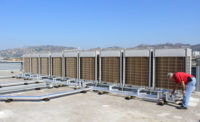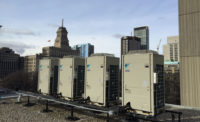VRF Manufacturers Provide Support
Offerings include channel-specific training, marketing materials, and more

TECHNICALLY SPEAKING: Technical service advisors (TSAs) from Fujitsu General America Inc. are available in each territory to help out with technical aspects of variable refrigerant flow (VRF) systems.

BY DESIGN: Contractors have access to Fujitsu’s free design software, so that they may design systems from their office or during an appointment with a customer.

LOCAL SUPPORT: Fujitsu’s sales engineers are located regionally and can provide phone support, on-site start-up, troubleshooting, and commissioning.

SERVICE TRAINING: Mitsubishi Electric encourages contractors to participate in its training courses to ensure they provide the best service possible.

FULL ACCESS: Panasonic offers its variable refrigerant flow (VRF) dealers support that can be accessed by phone, online, or in person. Free application and sales training is also available.





When contractors decide to offer a new brand of equipment or a new type of technology, they want to make sure the manufacturer will be there to support them. This support can include everything from channel-specific training classes to marketing materials to design and installation assistance to easy-to-use apps and software that can help facilitate the sales process.
When it comes to offering VRF systems, contractors are particularly interested in manufacturer support because many are new to the technology. They want to make sure they have a steadfast partner that will be able to help them learn how to sell, design, install, and service the equipment as well as be available to answer any questions or concerns that might pop up in the field. VRF manufacturers understand these concerns and, as a result, offer a wide array of support services that are designed to help their contractors be successful.
FULL SUPPORT
Manufacturer support typically includes sales and technical help, so contractors can feel confident in both selling and designing VRF systems. To that end, Mitsubishi Electric offers design software, online resources, and extensive in-person training at its eight regional training centers across the country. “For VRF, our in-person courses are offered at least once per week, and additional courses can be taken with our distributors and representatives,” said Kevin Miskewicz, director of commercial marketing, Mitsubishi Electric US Inc. Cooling & Heating Division.
Mitsubishi Electric requires its contractors to meet all local and state compliance and licensing requirements and also encourages them to participate in its training courses to ensure they provide the best service possible. For example, the company offers a three-day CITY MULTI® service course, which couples an in-depth functional study of the VRF system along with practical hands-on exercises associated with properly applying, installing, commissioning, and troubleshooting systems. “We also offer CITY MULTI application courses and maintenance tool diagnostics courses as well as controls applications training, Diamond Designer training, and more,” said Miskewicz.
As far as software is concerned, Mitsubishi Electric offers the Diamond System Builder™, which allows specifiers to lay out and design commercial HVAC systems. It ensures that the system is properly designed within the required constraints and checks that the line lengths, maximum connected capacities, component selection, and control scheme are within the system requirements, noted Miskewicz. “The software also generates AutoCAD® schematics with wiring and piping diagrams to streamline the installation process.”
Fujitsu General America Inc. also offers a tremendous amount of support to contractors, starting with its sales engineers, who are located regionally and can provide phone support, on-site start-up, troubleshooting, and commissioning. Technical service advisors (TSAs) are also available in each territory to help out with technical aspects of the VRF system. Online, Fujitsu’s Airstage VRF (and Halcyon) portal offers sales materials, such as catalogs, sell sheets, and mini brochures. It also has detailed technical resources, such as design and technical manuals, cut sheets, installation and operation manuals, and technical bulletins.
“Contractors also have access to download our free design software, so that they may design systems from their office or at an appointment with a customer,” said CJ Corbet, Southwest sales engineer, Fujitsu General America Inc. “We also offer a variety of training courses, including portal-based instruction and one-day courses that can be conveniently taught at a contractor’s office or at one of our many regional training facilities.”
In order to provide a more hands-on experience, Fujitsu recently opened its Airstage on Broadway, Fujitsu General’s Solution Center in New York City. The new 1,600-square foot location is designed to be a learning and sharing center where architects, engineers, building owners, contractors, energy consultants, and HVAC customers can come together to collaborate and share experiences. The showroom will also display a variety of Fujitsu’s commercial and residential heating and cooling systems.
Panasonic Corp. offers its VRF dealers support that can be accessed by phone, online, or in person. At its three training facilities, contractors and engineers can obtain free application and sales training, which includes the distribution of application software and instruction on how to use it. “The design software is an essential part of eliminating risks ensuring that line set diameter and limitations are followed,” said Malcolm Persaud, senior manager of commercial products, air conditioning group, Panasonic. “That is why contractors should take advantage of the free training. Other opportunities include hands-on or web-based training that covers installation, commissioning, and service issues.”
NEVER ALONE
When installing a new product for the first time, there is always some degree of apprehension, but after obtaining the proper training, contractors will find VRF to be an installer-friendly technology, said Persaud. “After one installation, most of the apprehension is removed. We have a program that guides contractors through the initial process, as it is also in our interest to ensure that we have great installations and operations.”
For contractors new to VRF, there are two common mistakes that can occur during the installation process: refrigerant leaks and communication issues. Both can be avoided if contractors attend proper training, said Corbet. “As we teach in class, proper refrigerant piping installation techniques are required for installation, and a broad overview of the communication systems are covered to eliminate most start-up errors. We also cover training on our computer-based service software, Service Tool, which helps identify specific errors in our Airstage VRF systems. I would recommend contractors take advantage of our free, one-day course and let us show how easy it is to install an Airstage VRF system and alleviate some of those concerns.”
While VRF is easy to install in new buildings, it is especially easy to install in retrofit applications, said Miskewicz, as ductwork is limited or not required at all. “Indoor units can be mounted just about anywhere – on the ceiling, wall, floor, in a closet, or elsewhere. VRF has minimal impact on building exteriors, too, because outdoor condensing units are compact and light enough to be placed on rooftops without compromising buildings’ structural integrities. VRF systems are easy to handle, cost less to transport, and require only a 3-inch opening in the exterior of a building for the refrigerant lines and wiring to connect the outdoor units to the indoor units.”
Manufacturers have a vested interest in making sure their products are designed, installed, and serviced properly, which is why they have devoted so many resources to sales and technical support. And while support is crucial for contractors just starting out with VRF, experienced contractors should take advantage of these opportunities, as well. “Ongoing training is the best way for contractors to stay at the forefront of their field,” said Miskewicz. “With the rapidly changing landscape of HVAC and VRF technology, ongoing training will ultimately make a contractor more knowledgeable in the eyes of their customers.”
Publication date: 2/13/2017
Want more HVAC industry news and information? Join The NEWS on Facebook, Twitter, and LinkedIn today!











